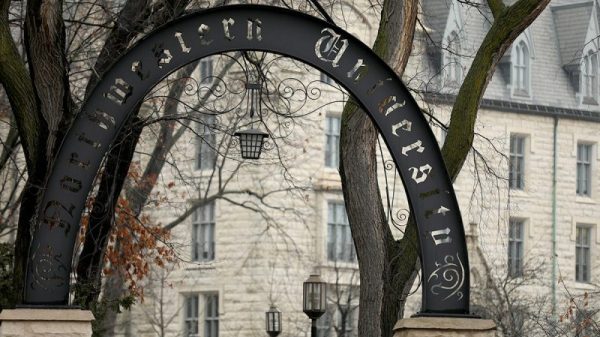Ohio voters headed to the polls Tuesday to decide whether to make it harder to amend the state constitution in a special election that has tremendous implications for the fate of abortion rights in the state.
For more than a century, Ohio voters have been able to amend the state constitution with a simple majority. The measure up for a vote on Tuesday would change that threshold to 60 percent.
If voters approve the amendment, they will set a much higher bar for passing a constitutional amendment guaranteeing abortion rights that is scheduled for November. Because of those stakes, Tuesday’s election has become a proxy fight over abortion.
Ohio special election
End of carousel
Republicans who control the state legislature scheduled the election as abortion rights advocates gathered signatures this spring for the November measure. Republican leaders have said they wanted to make the abortion rights measure tougher to pass but also have embraced the proposal more broadly, saying changes to the state constitution should have overwhelming support. Opponents of changing the rules have called the measure anti-democratic, saying the nation is founded on the idea of majority rule.
Millions of dollars have been spent on Tuesday’s election, and turnout has been high for an election held during a normally sleepy political season. More than 600,000 people voted early — more than twice as many as voted early in the May 2022 primary for U.S. Senate.
The measure, known as Issue 1, is the only item on the ballot. Polls were scheduled to close at 7:30 p.m., and election officials will tally the results over the coming hours.
The measure needs only a simple majority to pass and will affect all constitutional amendments on the ballot going forward, including the November abortion rights measure.
Regardless of the outcome, attention will turn immediately to the November election on abortion. Since the Supreme Court last year ended a nationwide right to abortion, voters in three states backed state constitutional amendments ensuring access to the procedure: Michigan, Vermont and California. In addition, voters in two conservative-leaning states, Kansas and Kentucky, rejected referendums that would have changed their constitutions to explicitly say they do not provide a right to abortion.
Tuesday’s vote could help foreshadow the outcome of the abortion measure in November. According to a July poll from USA Today and Suffolk University, 58 percent of likely voters supported the abortion rights ballot measure. That suggests it could pass under current rules but might fall short of the 60 percent threshold.
Tuesday’s vote has drawn national attention. Mike Pence, the former vice president seeking the GOP nomination for president, released a video Tuesday urging Ohioans to vote “yes” so they could block the November abortion rights amendment, “stop the radical left” and “save Ohio.” Rep. Nancy Pelosi (D-Calif.), meanwhile, in a Twitter post called on voters to cast “no” ballots because “voting rights and reproductive freedoms are on the line.”
Retired attorney Richard Russeth, 67, voted against the measure Tuesday at an elementary school in Middletown, a city of 50,000 between Cincinnati and Dayton.
“I am not against having a supermajority, but they are only doing this to defeat abortion,” he said. “They are changing the rules in the middle of the game and that doesn’t fly with me.”
Several miles away, in rural Wayne Township, Jim Gentry, 84, said he voted for the measure because of his opposition to abortion.
“I don’t want them fooling with the constitution,” said Gentry, a retired truck driver.
In recent years, Republicans in a handful of states have sought to make it more difficult to pass citizen-led initiatives after a string of liberal policies — from expanding Medicaid to raising the minimum wage — have been placed on the ballot. Last year, such efforts to raise the voter threshold failed in South Dakota and Arkansas, and attempts to schedule a similar vote in Missouri were unsuccessful this spring.
“Ohio is going to shape the contours of this conversation going forward,” said Sarah Walker, the policy and legal advocacy director at the Ballot Initiative Strategy Center, which helps with liberal ballot measures.
She added, “If it’s a resounding defeat, it will send a very strong message that it is not in the interest of policymakers to attempt to restrict the citizen-initiative process.”
Yet, some people intricately involved in ballot measure campaigns don’t think a defeat in Ohio would stop Republican lawmakers in other states from asking voters to raise the bar for constitutional amendments, or make it harder for them to get on the ballot in the first place.
“I think we have seen a pretty steady drumbeat of these attacks coming for ballot measures,” said Kelly Hall, executive director of the Fairness Project, which funds and organizes liberal state ballot measure efforts across the country.
In Ohio, millions of dollars have flowed to both opponents and proponents of the measure, from within the state and outside it. Groups that support the November abortion rights effort and those opposing Tuesday’s ballot measure have raised about $25 million. Those on the other side have secured about $20 million, according to campaign finance filings.
Michael Gonidakis, the president of Ohio Right to Life, lobbied the state legislature for months to try to make it harder to pass constitutional amendments. Those efforts were successful in May, and since then, he has traveled across the state pitching the argument that powerful out-of-state groups want to wield outsize influence on Ohio.
Supporters of Tuesday’s measure argue that raising the threshold for constitutional amendments is about more than abortion. They point to an array of other liberal-leaning issues that could appear on future ballots, such as raising the minimum wage and legalizing marijuana. They contend it is too easy to amend the state constitution, and that there should be a high bar for modifying it like there is for the U.S. Constitution.
“A simple 50 percent-plus-one majority shouldn’t be able to change the rules that we use to govern our state,” said Frank LaRose, Ohio’s Republican secretary of state, who has launched a bid for U.S. Senate. “This is about protecting our state constitution.”
Abortion rights advocates banded together with other groups to reject Tuesday’s measure. They acknowledged that passage of Tuesday’s measure would make it more challenging to pass the abortion rights initiative and require an even bigger campaign — and more money.
“We’re hoping that that doesn’t happen,” said Lauren Beene, executive director of Ohio Physicians for Reproductive Rights. “But if it does, we will be here, and we are not going to stop fighting.”
Other groups have largely avoided discussion of abortion to talk about the issue on Tuesday’s ballot. They have argued it is unfair to let a minority block the will of the voters.
“This ability to take something to the ballot and have a constitutional amendment is our last line of defense,” said Melissa Cropper, the president of the Ohio Federation of Teachers. “That’s the beauty of being in Ohio, is that we have the ability to go to the ballot and make a change. And we shouldn’t be sacrificing it.”
The day the Supreme Court overturned the constitutional right to an abortion, a ban went into effect in Ohio on abortion after fetal cardiac activity is detected, often at six weeks of pregnancy. But nearly three months later, in September 2022, a Hamilton County judge blocked the abortion ban, and a lawsuit is wending its way through the courts.
Where is abortion legal and illegal?
End of carousel
More recently, abortion rights supporters gathered signatures at places like grocery stores, religious centers, large concerts and festivals in a quest to get a measure protecting access to abortion on the ballot this November. The secretary of state determined in July that their effort was successful. Two Republicans have sued to try to block the November election.
The focus of Tuesday’s vote has been on the higher threshold it would set for passing future constitutional amendments. But the measure would also make it tougher to place initiatives on the ballot in the first place.
Under long-standing rules, those who want to place constitutional amendments on the ballot must gather signatures equal to 10 percent of the number of people who voted in the most recent race for governor. Signatures must be collected in at least 44 of Ohio’s 88 counties, with the total from each county equaling at least 5 percent of the votes cast in the governor’s race.
If the secretary of state determines that the backers of the ballot measure have not turned in enough valid signatures, they are given 10 days to gather more.
Issue 1 would change those rules by requiring petitioners to hit the 5 percent mark in every Ohio county and ending the ability to gather additional signatures.
Brenda Perkins, 66, voted against the measure at Rosa Parks Elementary School in Middletown. Perkins, a retired teacher, reflected on the national attention on the special election.
“The whole world,” she said, “is watching Ohio.”
Ohio voters headed to the polls Tuesday to decide whether to make it harder to amend the state constitution in a special election that has tremendous implications for the fate of abortion rights in the state.
For more than a century, Ohio voters have been able to amend the state constitution with a simple majority. The measure up for a vote on Tuesday would change that threshold to 60 percent.
If voters approve the amendment, they will set a much higher bar for passing a constitutional amendment guaranteeing abortion rights that is scheduled for November. Because of those stakes, Tuesday’s election has become a proxy fight over abortion.
Ohio special election
End of carousel
Republicans who control the state legislature scheduled the election as abortion rights advocates gathered signatures this spring for the November measure. Republican leaders have said they wanted to make the abortion rights measure tougher to pass but also have embraced the proposal more broadly, saying changes to the state constitution should have overwhelming support. Opponents of changing the rules have called the measure anti-democratic, saying the nation is founded on the idea of majority rule.
Millions of dollars have been spent on Tuesday’s election, and turnout has been high for an election held during a normally sleepy political season. More than 600,000 people voted early — more than twice as many as voted early in the May 2022 primary for U.S. Senate.
The measure, known as Issue 1, is the only item on the ballot. Polls were scheduled to close at 7:30 p.m., and election officials will tally the results over the coming hours.
The measure needs only a simple majority to pass and will affect all constitutional amendments on the ballot going forward, including the November abortion rights measure.
Regardless of the outcome, attention will turn immediately to the November election on abortion. Since the Supreme Court last year ended a nationwide right to abortion, voters in three states backed state constitutional amendments ensuring access to the procedure: Michigan, Vermont and California. In addition, voters in two conservative-leaning states, Kansas and Kentucky, rejected referendums that would have changed their constitutions to explicitly say they do not provide a right to abortion.
Tuesday’s vote could help foreshadow the outcome of the abortion measure in November. According to a July poll from USA Today and Suffolk University, 58 percent of likely voters supported the abortion rights ballot measure. That suggests it could pass under current rules but might fall short of the 60 percent threshold.
Tuesday’s vote has drawn national attention. Mike Pence, the former vice president seeking the GOP nomination for president, released a video Tuesday urging Ohioans to vote “yes” so they could block the November abortion rights amendment, “stop the radical left” and “save Ohio.” Rep. Nancy Pelosi (D-Calif.), meanwhile, in a Twitter post called on voters to cast “no” ballots because “voting rights and reproductive freedoms are on the line.”
Retired attorney Richard Russeth, 67, voted against the measure Tuesday at an elementary school in Middletown, a city of 50,000 between Cincinnati and Dayton.
“I am not against having a supermajority, but they are only doing this to defeat abortion,” he said. “They are changing the rules in the middle of the game and that doesn’t fly with me.”
Several miles away, in rural Wayne Township, Jim Gentry, 84, said he voted for the measure because of his opposition to abortion.
“I don’t want them fooling with the constitution,” said Gentry, a retired truck driver.
In recent years, Republicans in a handful of states have sought to make it more difficult to pass citizen-led initiatives after a string of liberal policies — from expanding Medicaid to raising the minimum wage — have been placed on the ballot. Last year, such efforts to raise the voter threshold failed in South Dakota and Arkansas, and attempts to schedule a similar vote in Missouri were unsuccessful this spring.
“Ohio is going to shape the contours of this conversation going forward,” said Sarah Walker, the policy and legal advocacy director at the Ballot Initiative Strategy Center, which helps with liberal ballot measures.
She added, “If it’s a resounding defeat, it will send a very strong message that it is not in the interest of policymakers to attempt to restrict the citizen-initiative process.”
Yet, some people intricately involved in ballot measure campaigns don’t think a defeat in Ohio would stop Republican lawmakers in other states from asking voters to raise the bar for constitutional amendments, or make it harder for them to get on the ballot in the first place.
“I think we have seen a pretty steady drumbeat of these attacks coming for ballot measures,” said Kelly Hall, executive director of the Fairness Project, which funds and organizes liberal state ballot measure efforts across the country.
In Ohio, millions of dollars have flowed to both opponents and proponents of the measure, from within the state and outside it. Groups that support the November abortion rights effort and those opposing Tuesday’s ballot measure have raised about $25 million. Those on the other side have secured about $20 million, according to campaign finance filings.
Michael Gonidakis, the president of Ohio Right to Life, lobbied the state legislature for months to try to make it harder to pass constitutional amendments. Those efforts were successful in May, and since then, he has traveled across the state pitching the argument that powerful out-of-state groups want to wield outsize influence on Ohio.
Supporters of Tuesday’s measure argue that raising the threshold for constitutional amendments is about more than abortion. They point to an array of other liberal-leaning issues that could appear on future ballots, such as raising the minimum wage and legalizing marijuana. They contend it is too easy to amend the state constitution, and that there should be a high bar for modifying it like there is for the U.S. Constitution.
“A simple 50 percent-plus-one majority shouldn’t be able to change the rules that we use to govern our state,” said Frank LaRose, Ohio’s Republican secretary of state, who has launched a bid for U.S. Senate. “This is about protecting our state constitution.”
Abortion rights advocates banded together with other groups to reject Tuesday’s measure. They acknowledged that passage of Tuesday’s measure would make it more challenging to pass the abortion rights initiative and require an even bigger campaign — and more money.
“We’re hoping that that doesn’t happen,” said Lauren Beene, executive director of Ohio Physicians for Reproductive Rights. “But if it does, we will be here, and we are not going to stop fighting.”
Other groups have largely avoided discussion of abortion to talk about the issue on Tuesday’s ballot. They have argued it is unfair to let a minority block the will of the voters.
“This ability to take something to the ballot and have a constitutional amendment is our last line of defense,” said Melissa Cropper, the president of the Ohio Federation of Teachers. “That’s the beauty of being in Ohio, is that we have the ability to go to the ballot and make a change. And we shouldn’t be sacrificing it.”
The day the Supreme Court overturned the constitutional right to an abortion, a ban went into effect in Ohio on abortion after fetal cardiac activity is detected, often at six weeks of pregnancy. But nearly three months later, in September 2022, a Hamilton County judge blocked the abortion ban, and a lawsuit is wending its way through the courts.
Where is abortion legal and illegal?
End of carousel
More recently, abortion rights supporters gathered signatures at places like grocery stores, religious centers, large concerts and festivals in a quest to get a measure protecting access to abortion on the ballot this November. The secretary of state determined in July that their effort was successful. Two Republicans have sued to try to block the November election.
The focus of Tuesday’s vote has been on the higher threshold it would set for passing future constitutional amendments. But the measure would also make it tougher to place initiatives on the ballot in the first place.
Under long-standing rules, those who want to place constitutional amendments on the ballot must gather signatures equal to 10 percent of the number of people who voted in the most recent race for governor. Signatures must be collected in at least 44 of Ohio’s 88 counties, with the total from each county equaling at least 5 percent of the votes cast in the governor’s race.
If the secretary of state determines that the backers of the ballot measure have not turned in enough valid signatures, they are given 10 days to gather more.
Issue 1 would change those rules by requiring petitioners to hit the 5 percent mark in every Ohio county and ending the ability to gather additional signatures.
Brenda Perkins, 66, voted against the measure at Rosa Parks Elementary School in Middletown. Perkins, a retired teacher, reflected on the national attention on the special election.
“The whole world,” she said, “is watching Ohio.”





















